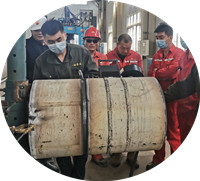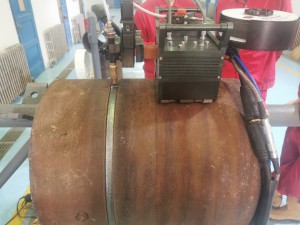Comparison of Four Non-destructive Testing Methods
Non-destructive testing is to use the characteristics of sound, light, magnetism and electricity to detect whether there are defects or inhomogeneities in the inspected object without damaging or affecting the performance of the inspected object, and to give the size, location, and location of the defect. The general term for all technical means used to determine the technical status of the inspected object (such as qualified or not, remaining life, etc.) by information such as nature and quantity.
Commonly used non-destructive testing methods: ultrasonic testing (UT), magnetic particle testing (MT), liquid penetration testing (PT) and X-ray testing (RT).
I. Magnetic particle inspection
Let’s first understand the principle of magnetic particle detection. After the ferromagnetic material and the workpiece are magnetized, due to the existence of discontinuities, the magnetic field lines on the surface and near the surface of the workpiece are locally distorted, resulting in a leakage magnetic field, which absorbs the magnetic powder applied on the surface of the workpiece, and forms a magnetic field that is visible under suitable light. Marks, thus showing the location, shape and size of the discontinuity.
The applicability and limitations of magnetic particle testing include:
1. Magnetic particle inspection is suitable for detecting discontinuities on the surface and near surface of ferromagnetic materials that are small in size and extremely narrow in gaps.
2. Magnetic particle testing can detect parts and components under various conditions, as well as various types of parts.
3. Defects such as cracks, inclusions, hair lines, white spots, folds, cold partitions and looseness can be found.
4. Magnetic particle testing cannot detect austenitic stainless steel materials and welds welded with austenitic stainless steel electrodes, nor can it detect non-magnetic materials such as copper, aluminum, magnesium, and titanium. It is difficult to find shallow scratches on the surface, deep holes buried, and delamination and folding with an angle of less than 20° with the surface of the workpiece.
II. Liquid penetration testing
The basic principle of liquid penetration detection, after the surface of the part is coated with fluorescent dye or colored dye, the penetrating liquid can penetrate into the surface opening defect under the action of capillary for a period of time;
After removing the excess penetrant on the surface of the part, the developer is applied to the surface of the part. Similarly, under the action of the capillary, the developer will attract the penetrant retained in the defect, and the penetrant will seep back into the developer. Under the light source (ultraviolet light or white light), the traces of the penetrating liquid at the defect are realized, (yellow-green fluorescence or bright red), so as to detect the morphology and distribution state of the defect.
The advantages of penetration testing are:
1. Various materials can be detected;
2. Has high sensitivity;
3. Intuitive display, convenient operation and low testing cost.
The disadvantages of penetration testing are:
1. It is not suitable for inspecting workpieces made of porous loose materials and workpieces with rough surfaces;
2. Penetration testing can only detect the surface distribution of the defect, and it is difficult to determine the actual depth of the defect, so it is difficult to make a quantitative evaluation of the defect. The detection result is also greatly influenced by the operator.
III. X-ray inspection
The last type, radiographic detection, is because X-rays will be lost after passing through the irradiated object. Different thicknesses and different substances have different absorption rates for them, and the film is placed on the other side of the irradiated object, which will be affected by the different intensity of the rays. The corresponding graphics are generated, and the critics can judge whether there are defects inside the object and the nature of the defects based on the images.
Applicability and limitations of radiographic testing:
1. It is more sensitive to detecting volume defects, and it is easier to qualitatively determine the defects.
2. The radiographic film is easy to retain and has traceability.
3. Visually display the shape and type of defects.
4. Disadvantages: the buried depth of the defects cannot be located, and the detection thickness is limited. The film needs to be sent and washed specially, and it is harmful to the human body, and the cost is high.
All in all, ultrasonic and X-ray flaw detection are suitable for detecting internal defects; among them, ultrasonic is suitable for parts with a regular shape and more than 5mm. X-rays cannot locate the buried depth of defects, and there is radiation. Magnetic particle and penetrant flaw detection are suitable for detecting surface defects of parts;
Among them, magnetic particle inspection is limited to the detection of magnetic materials, and penetrant inspection is limited to the detection of surface opening defects.
Post time: Jul-01-2021


